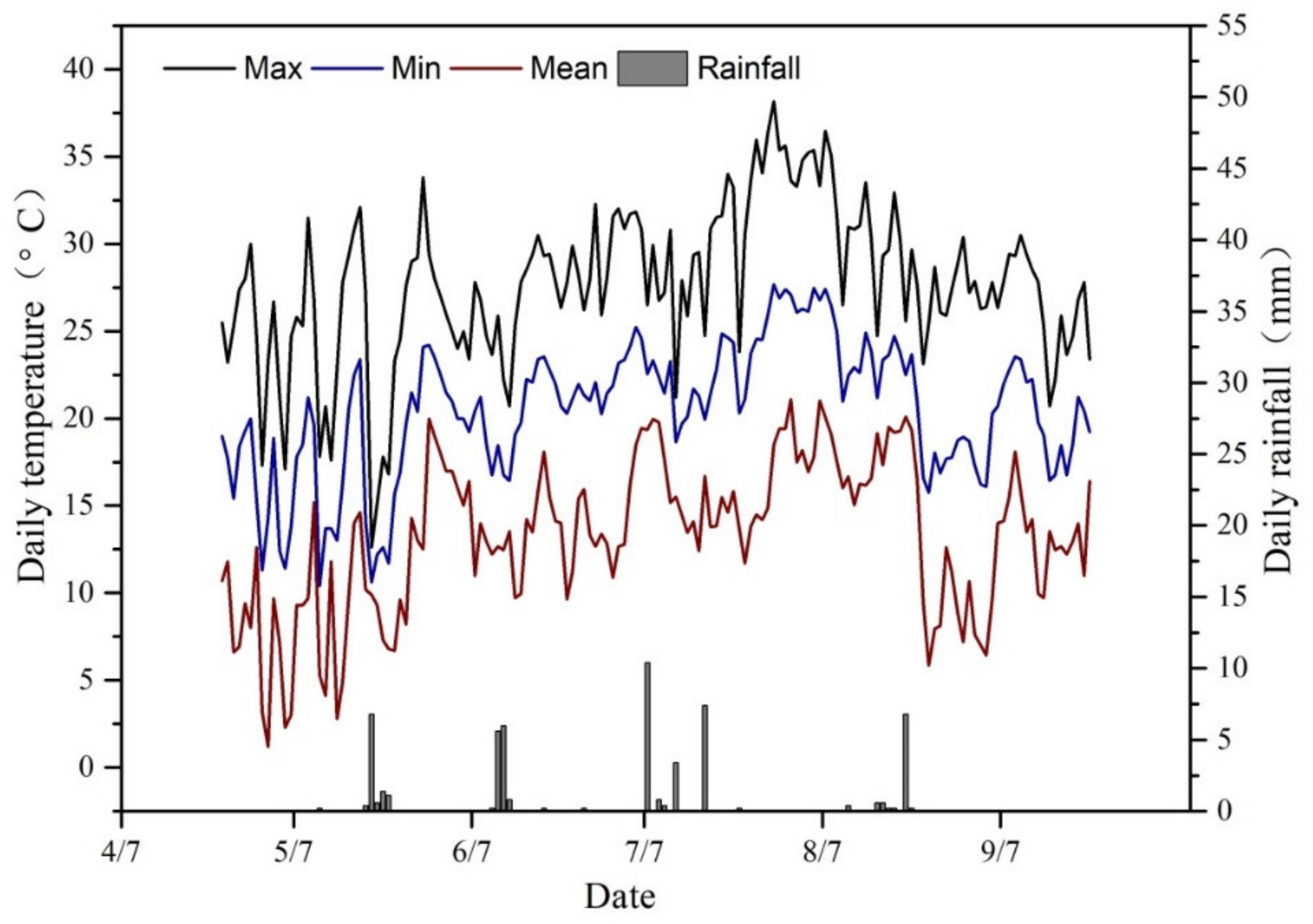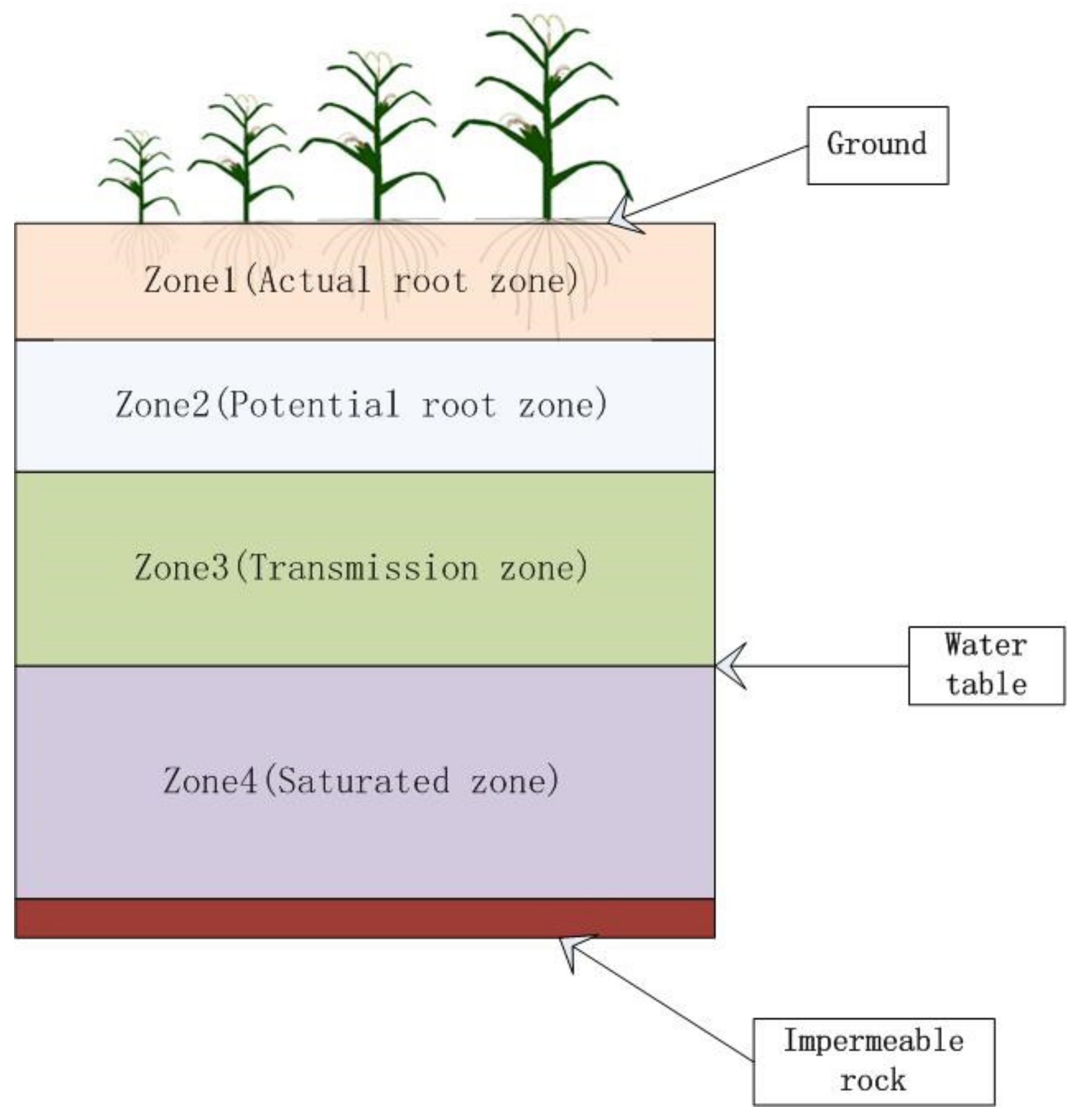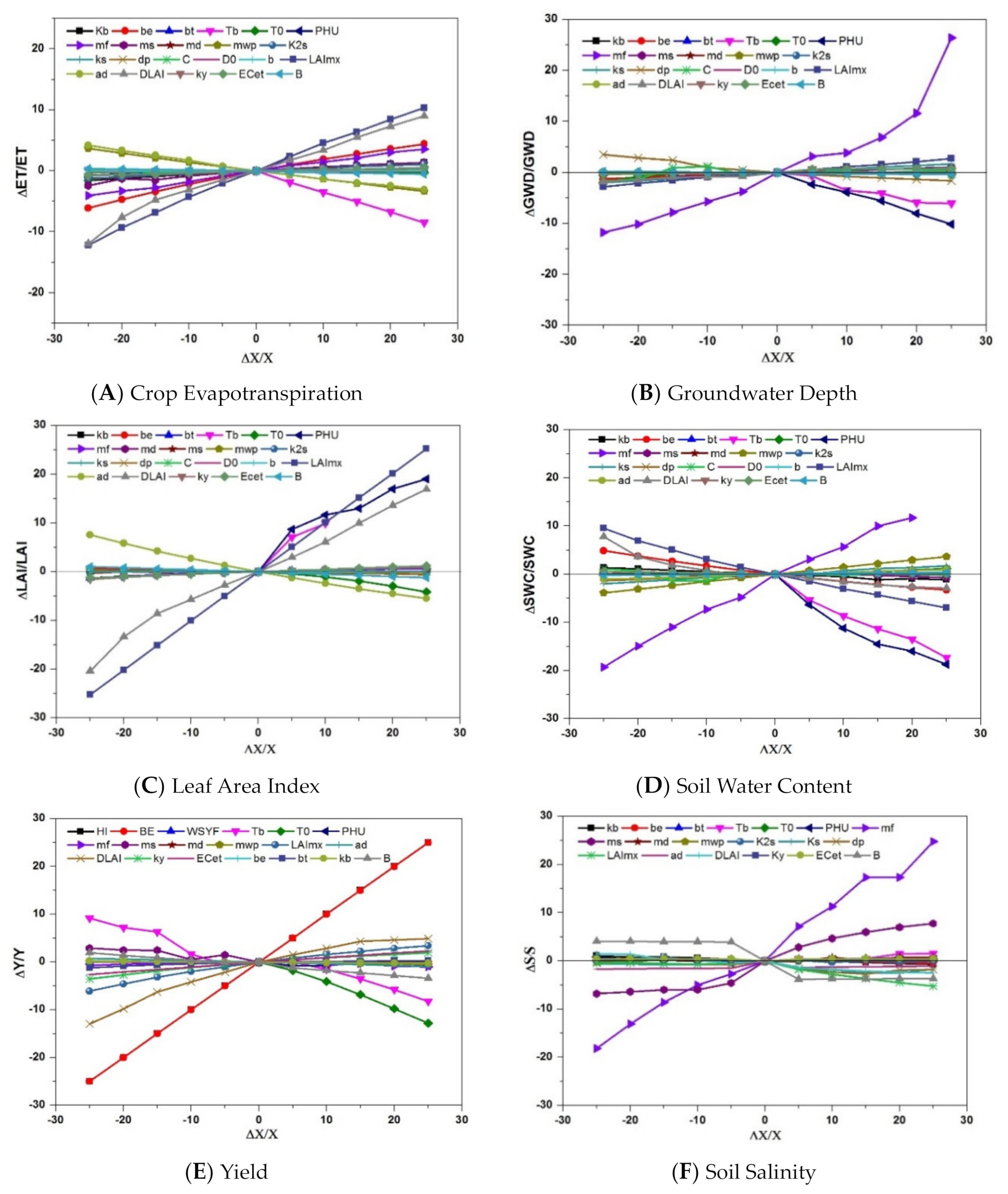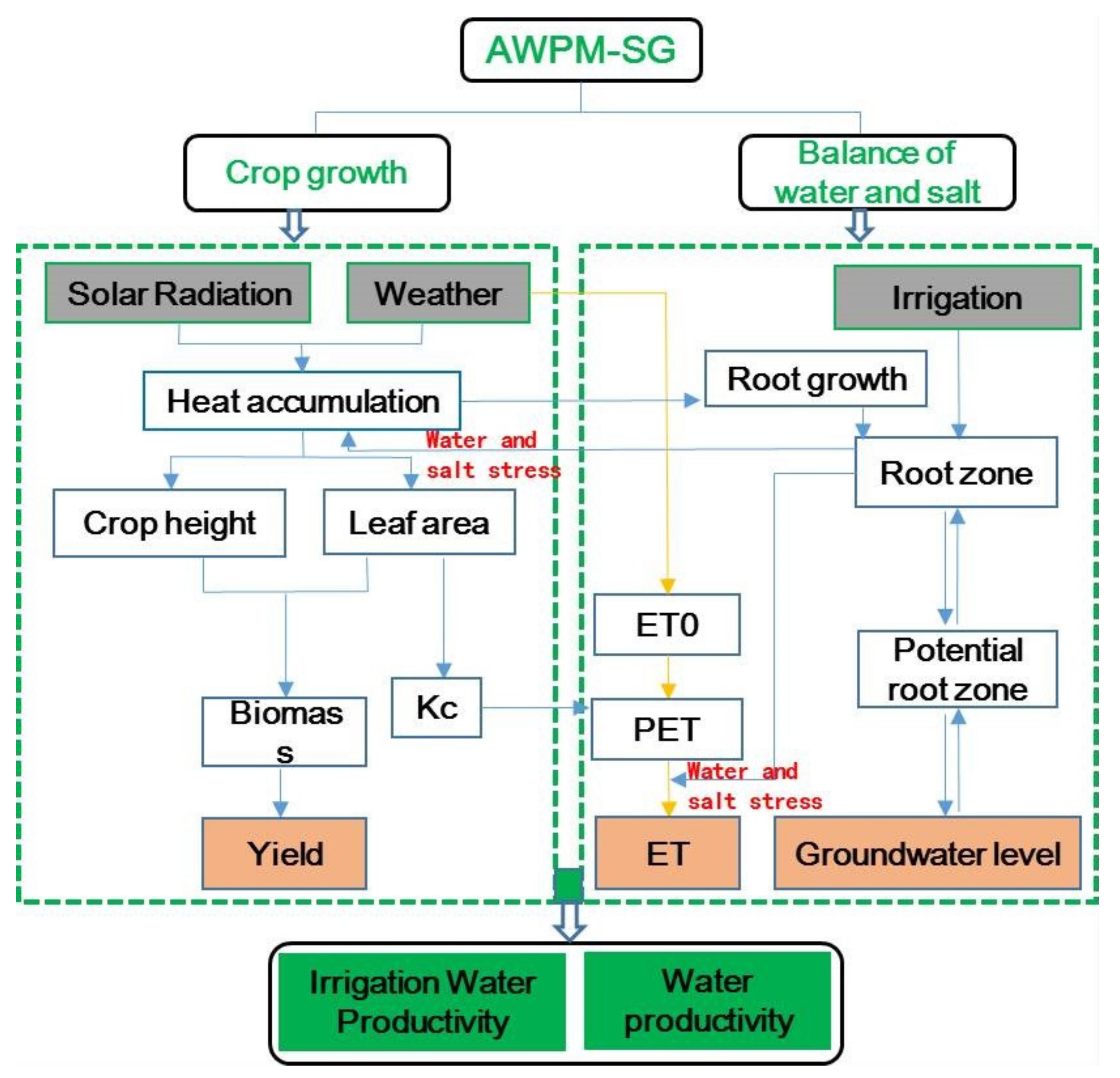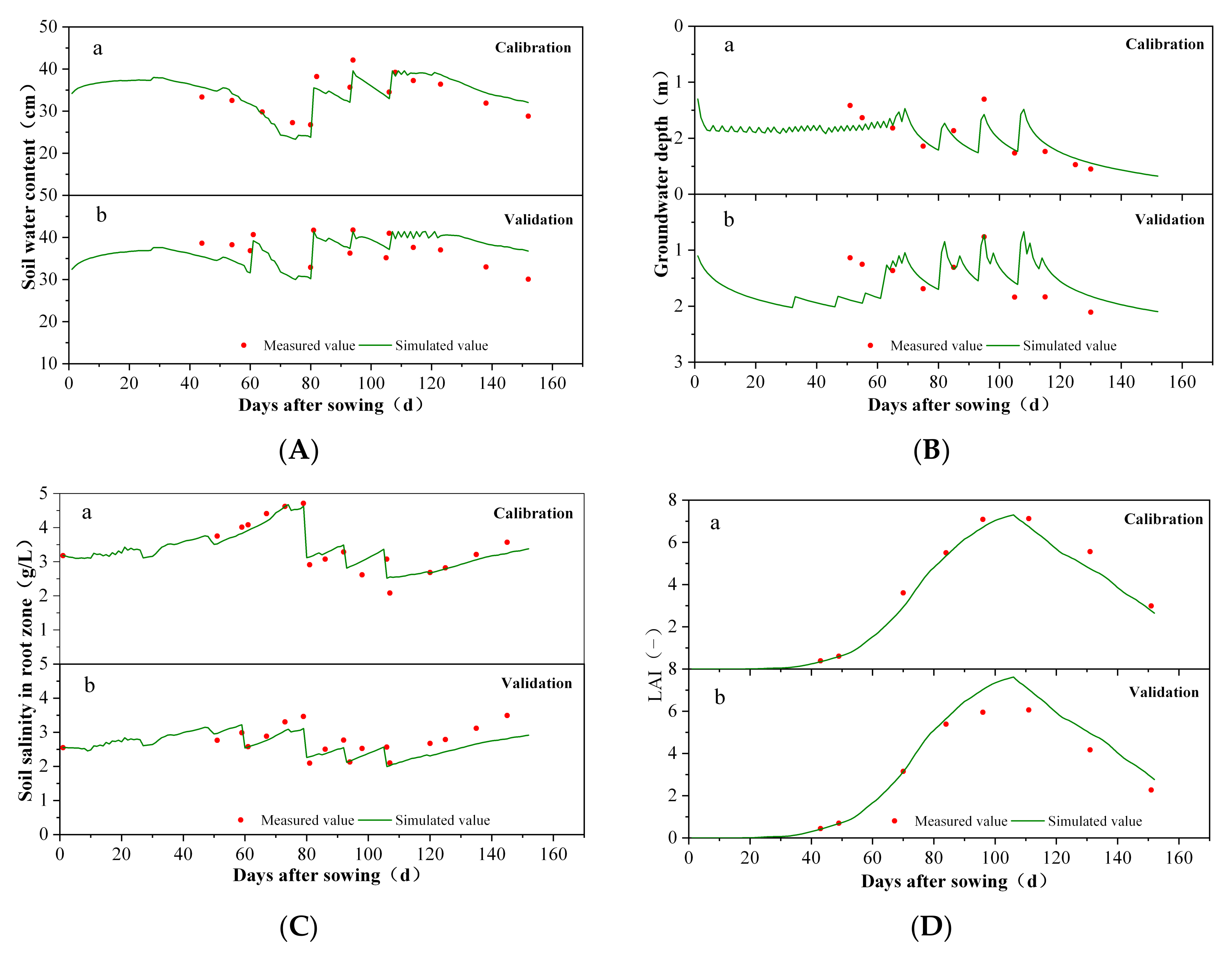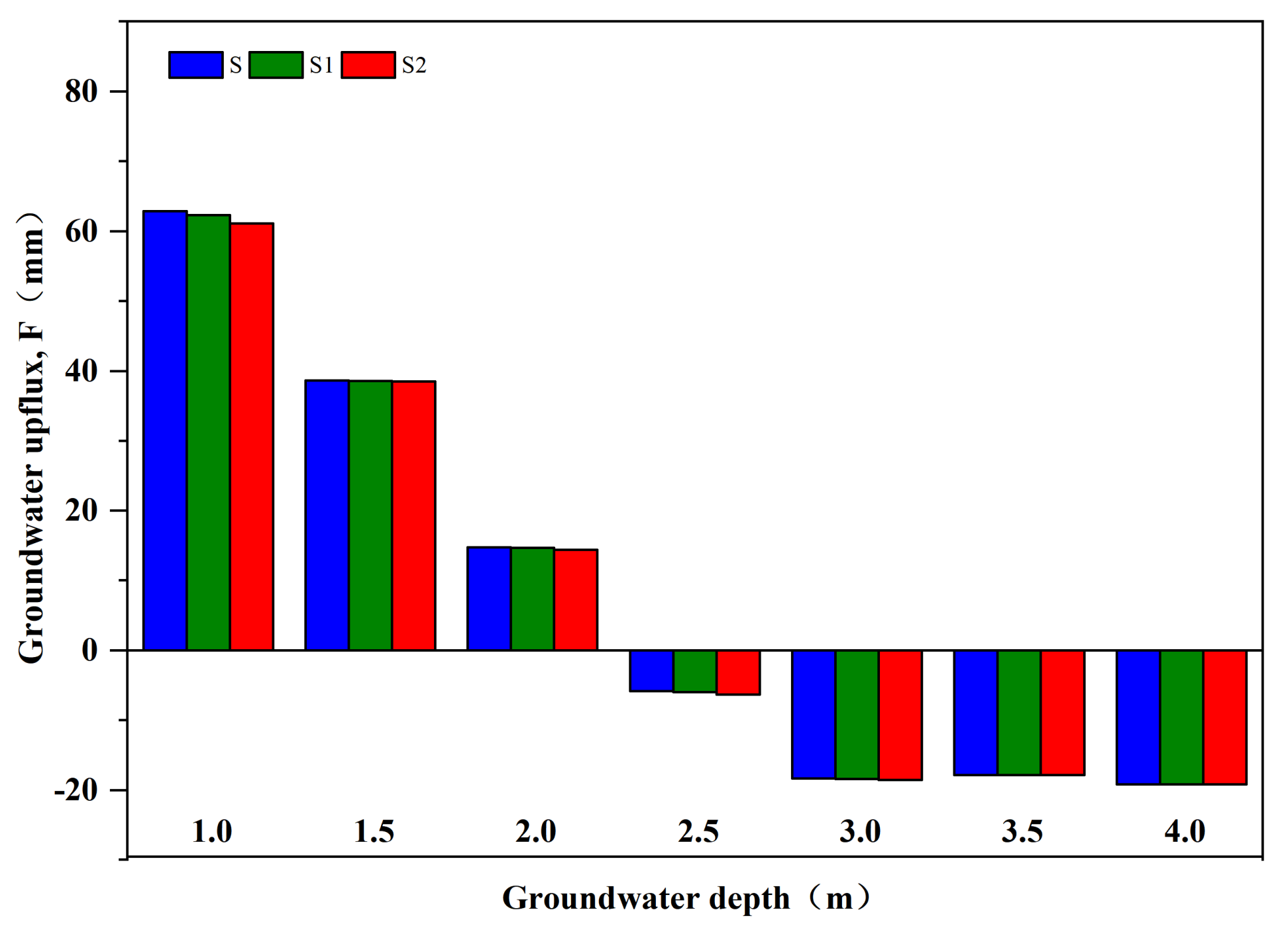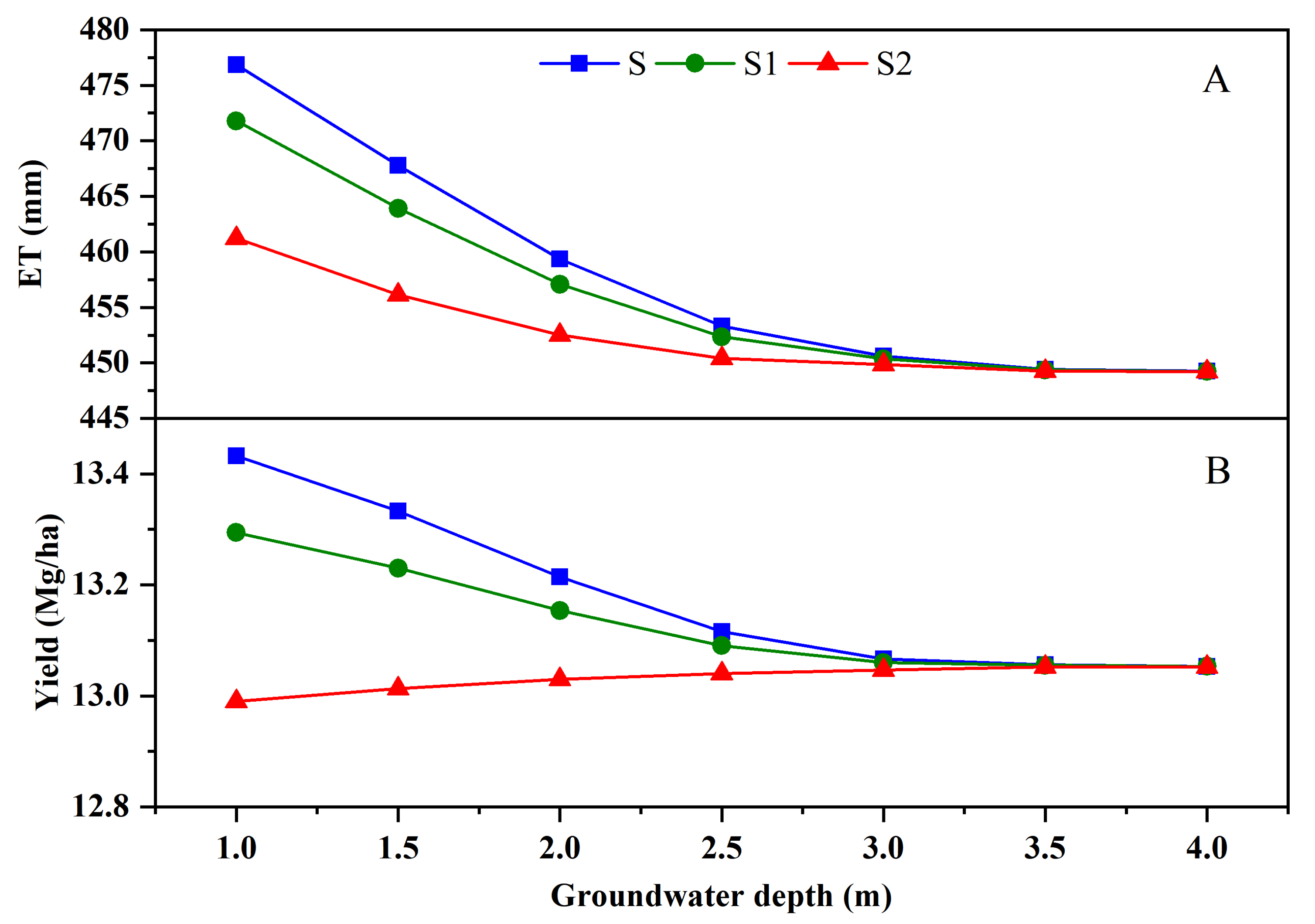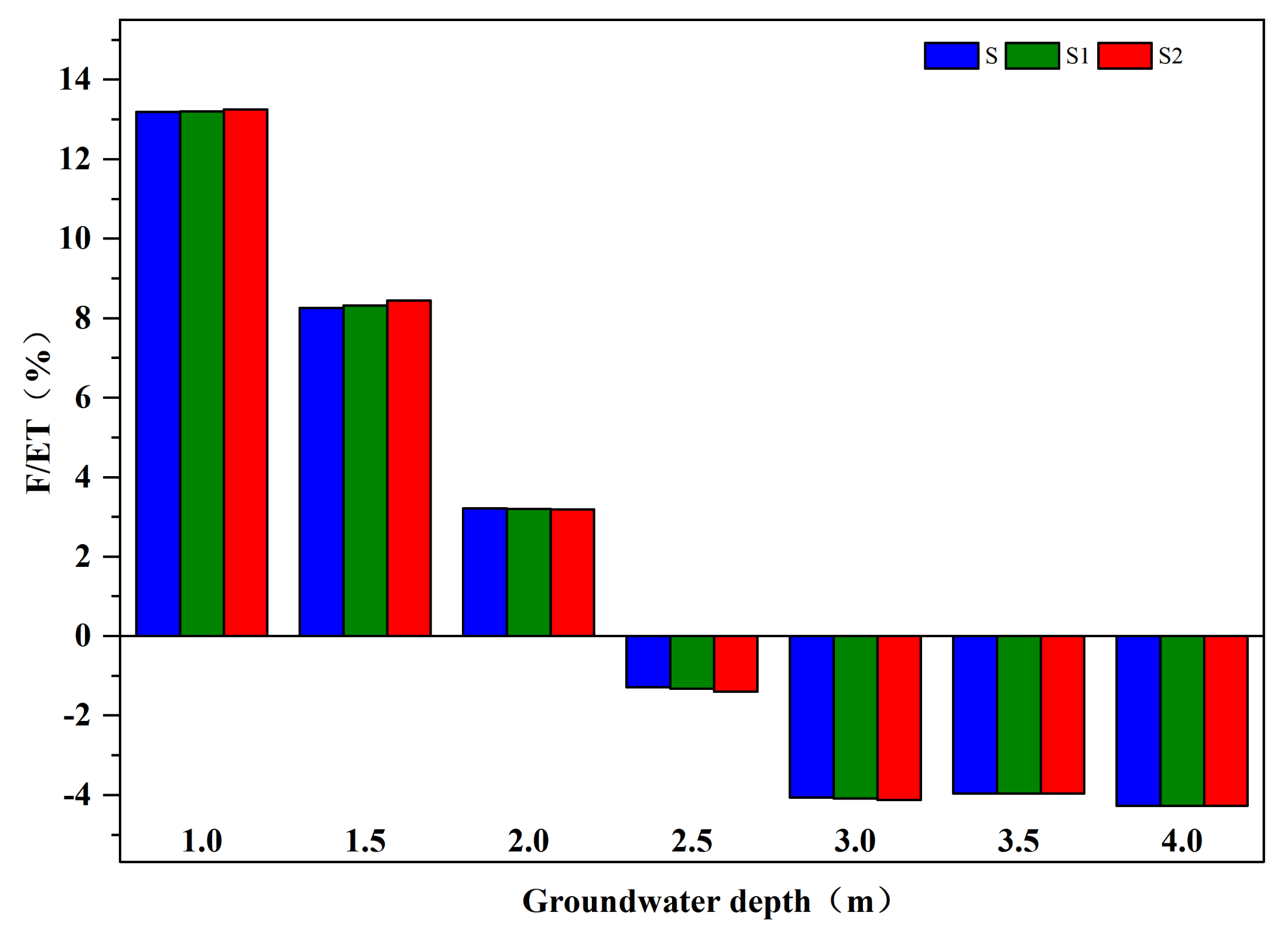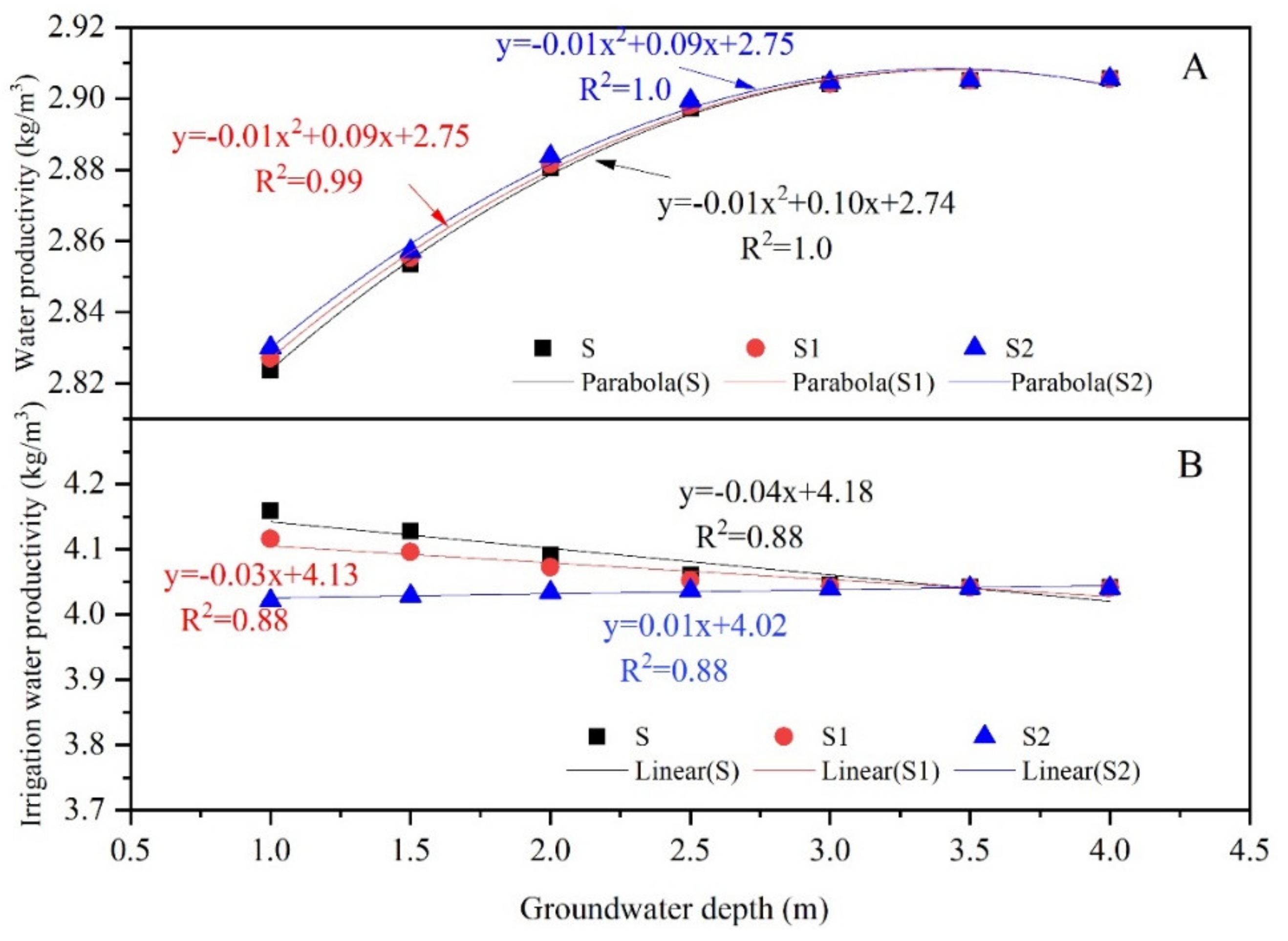1. Introduction
In many semi-arid and arid regions of the world, irrigated agriculture consumes most of the available water. For example, in China, agricultural water use accounts for 60% of the total water use and 90% of the agricultural water is used for irrigation [
1,
2]. Therefore, developing water-saving agriculture and enhancing water productivity are of great significance for ensuring water security, food security, and ecological security in China [
3].
In particular, in the Hetao irrigation district, which is a typical arid area with shallow groundwater and affected by soil salinization, various water-saving measures including lining of main, sub-main and distributor canals have been implemented since 2000 [
4,
5]. The application of water saving measures has led to a decline in the groundwater table that controls the waterlogging and salinity. Soil salinization is a serious environmental problem [
6,
7,
8]. Healthy soils and healthy land are the basic conditions for the successful implementation and realization of the sustainable development goals related to food, healthy water and climate [
9,
10,
11,
12,
13]. Therefore, understanding water and salt balance under shallow groundwater is significant for sustainable agriculture.
In districts with shallow groundwater, such as the Hetao Irrigation district, capillary rise from groundwater can be used to supplement surface water irrigation and in closed basins, it can possibly save water for irrigating additional areas. At the same time, the soil acts a filter for groundwater [
14]. Then capillary rise from groundwater depends on several factors such as groundwater table depth, soil hydraulic properties, crop growth stage, weather and irrigation [
15,
16]. According to the entropy model, land-use, soil order and rainfall factors had the highest impact on groundwater potential [
17]. Several studies have quantified the amount of water derived from groundwater and found that 20%–40% of the evapotranspiration can be met by capillary rise from water tables at depths of 0.70–1.50 m [
18,
19,
20,
21,
22,
23,
24]. With lysmeter experiments, Kahlown and Ashraf [
25] found that under the water table at 0.5 m depth, wheat met its entire water requirement from the groundwater and the sunflower’s required water absorbed from groundwater is greater than 80%.
Soil salinity is a limiting factor for crop growth, especially within shallow groundwater. Pan et al. used a Soil Water Atmosphere Plant (SWAP) model to simulate soil water-salt balance, summer maize yield and water use efficiency under different irrigation schedules [
26]. A modified HYDRUS model was used in simulating polyfluoroalkyl substances (PFAS) transport in the vadose zone [
27]. By analysing satellite-based remote sensing images, Yu et al. [
8] indicated that groundwater depth was the major controlling factor for regional soil salinity. Metternicht et al. [
28] adopted remote sensing to analyze the spatial distribution and temporal changes in soil salinity.
Yield, water productivity (WP), and irrigation water productivity (IWP) vary with both groundwater depth and soil salinity. Mejia et al. [
29] conducted a two-year study to investigate the effect of the groundwater table on the corn yield and found a 5%–10% greater yield for corn, and 23% for soybeans at 0.5–0.75 m groundwater depth compared with the same treatment with groundwater depth more than 1 m. Wang et al. [
30] investigated the water and salt transport features for saline soil through drip irrigation under film, and found that the increase in irrigation water would expand the standard district for the normal growth of plants. Huo et al. [
31] reported that irrigation water productivity (IWP) increased with shallower groundwater tables.
Although experimental results have indicated that shallow groundwater can contribute to crop water use, it is seldom used in irrigation scheduling because measuring the capillary upward flux is complex and cannot be performed routinely. Therefore, models are the only way to obtain fluxes. However, most of the irrigation management models assume that the groundwater is sufficiently deep that the water percolates downwards out of the plant roots [
32,
33,
34]. Several methods that can estimate the upward water such as Hydrus and SWAP are cumbersome because they require spatially varying input data such as the soil water retention curve and unsaturated hydraulic conductivity that are not easily available [
35]. Prathapar and Qureshi [
36] used the SWAP model to evaluate consequences of deficit irrigation in semi-arid areas with a shallow water table in Pakistan. Other models, such as by Healy and Cook [
37] and Ayars et al. [
38] are based on measured moisture content or water-table fluctuations and cannot be used in routine applications. Additionally, common numerical methods require a lot of verification and depend on soil parameters.
Because of the intensive data requirements of the above-mentioned models for use in irrigation management with shallow groundwater, the AWPM-SG was established in previous studies to simulate the water cycle in shallow groundwater areas. The objective of this study is, therefore, to (1) develop a modified model that couples soil water and salt and crop growth to analyze the field water and salt cycle and groundwater contribution to crop evapotranspiration; and (2) investigate the effect of groundwater depth and groundwater salinity on yield, crop evapotranspiration, water productivity and irrigation water productivity of maize. Without affecting the maize yield, the irrigation water can be reduced within a reasonable range.
2. Materials and Methods
2.1. Experiments
For model calibration and validation, field experiments by Wang in 2016 in Fenzidi located in the Hetao irrigation district were used. The experimental station was located in an open field and had a representative climate, soil, and groundwater conditions.
The Hetao irrigation district, is located in the western part of the Inner Mongolia Autonomous Region. The study site has a typically arid and semi-arid continental climate. The average annual rainfall is 142 mm and falls mainly from June to August. The average annual pan evaporation is 2300 mm. The average number of sunlight hours per month is 266 h. The mean annual temperature is 7 ℃, with monthly averages of −10.1 in January to 23.8 ℃ in July (
Figure A1 in the
Appendix B). Soils begin to freeze in the second half of November to a maximum depth of approximately 1.0–1.3 m, and is completely thawed by the middle of May. Groundwater depth varies between 1.2 and 3.8 m.
The experiment growing maize was carried out by Wang in 2016 [
39]. The maize (Kehe-8) commonly grown in Hetao was planted in late April and harvested in late September. Cultivation practices were similar to the practices of farmers and recommended by extension agents. Three times during the growing season 216 and 218 mm of water were applied for the field plots named F1 and F2 (
Table 1). The irrigation amount refers to the local farmers’ field. Nitrogen fertilizers were applied at a rate of 207 kg/ha for the first irrigation, and 103 kg/ha for the third irrigation in 2016.
During the growing period, the meteorological data, including air temperature, sunshine hours, relative humidity and wind speed were taken from micrometeorological stations in farmland and were used to calculate the FAO (Food and Agricultural Organization of the United Nations) Penman-Monteith reference evapotranspiration (ET
0). Daily rainfall was measured using a rain gauge at the experimental site. The rainfall was 55.1 mm, with more than 70% of precipitation occurring in July and August. The main weather data are shown in
Figure A1 in the
Appendix B.
The particle size distribution was obtained using a laser particle analyzer. The main physical properties of the soil are shown in
Table 2. In the root zone, the soil is silty loam, which is the representative soil texture in this region. The dry bulk density was obtained by oven drying undisturbed soil samples of 100 cm
3 at 105 °C for 48 h. Saturated hydraulic conductivity was estimated in eight 100 cm
3 undisturbed soil samples using a constant-head permeameter [
40]. Soil water retention curves were determined for each horizon in 100 cm
3 undisturbed soil samples using a pressure membrane apparatus (SEC-1000, Soilmoisture Equipment Corporation, CA, US). The fitted soil hydraulic parameters of the Muchlem-van Genuchten model are presented in
Table 3.
2.2. Data
The soil moisture content was measured every day using an Automatic Soil Moisture Monitor (Hydra Probe, Stevens Water Monitoring Systems, Inc., Portland, Oregon, USA). The soil moisture was measured at 20 cm intervals from the surface to a depth of 100 cm. At the same time, it was calibrated with drying method through earth-fetching at regular times.
Soil salinity was measured similarly to the soil water content. It was also measured every day using an automatic soil moisture monitor (Hydra Probe) at 20 cm intervals. Because the soil electrical conductivity (EC) monitored by Hydra Probe was affected by soil water and soil salinity, the soil electrical conductivity is directly related with soil water content. Two references that used Hydra Probe showed the results. In the study of Valdes et al., soil bulk EC (ECb) monitored by Hydra Probe is a function of both water and pore water EC (ECp). Then firstly we transfer the ECb to ECp based on soil water content [
41]. Leao et al. reported that soil apparent bulk electrical conductivity is a function of soil water content, pore solution electrical conductivity and solid phase electrical conductivity [
42]. We assumed the soil salinity is a function of soil water and soil electrical conductivity monitored by Hydra Probe. Because the monitored soil electrical conductivity needed to be modified according to the soil salinity obtained by earth-fetching, we take the regression as follows:
where S is the soil total salinity (g/kg), EC is the soil electrical conductivity monitored by Hydra Probe (ms/cm), and SWC is soil water content (cm
3/cm
3).
Figure A2 in the
Appendix B shows the contrast between the regression value and measured value.
The groundwater depth was monitored daily during the crop growth period by monitoring the piezo metric head of the probe (Hobe 20).
The crop leaf area index (LAI) was measured every 6–12 days using a leaf area metre (YMJ-B).
Dry maize yield was determined after harvesting.
2.3. Model Description
2.3.1. Modified Agricultural Water Productivity Model for Shallow Groundwater
In this study, considering the high soil salinity in the Hetao irrigation area, the developed Agricultural Water Productivity Model for Shallow Groundwater (AWPM-SG) model was modified to simulate the actual soil water, soil salinity and groundwater depth. The developed AWPM-SG is the coupling of a crop growth Environmental Policy Integrated Climate (EPIC) model and a soil moisture model of the Watershed Irrigation Potential Estimation (WIPE) root and vadose zone that simulates both upward movement from groundwater and percolation to the groundwater. This was originally developed by Saleh et al. for investigating the impact of irrigation management schemes on groundwater levels in Bangladesh [
43,
44]. The structure of the modified AWPM-SG is shown in
Figure 1. The model simulates water and salt flux on daily time steps and require few parameters (soil hydraulic parameters and crop growing parameters), which are listed in
Table 3 and
Table 4 and. The three parts of the modified AWPM-SG consist of a crop module, an actual evapotranspiration module and a soil module, which are coupled for the first time in the AWPM-SG [
15] (
Figure A3 drawn by Xiaoyu Gao in the
Appendix B). This modified model mainly considers soil salt transport and its effect on crop growth, especially in the shallow groundwater district (Method in
Appendix A). The modified model is described in detail in the
Appendix A. An overview of modified AWPM-SG is given below.
2.3.2. Crop Module Considering Soil Salinity
The crop module of AWPM-SG is mainly based on the Environmental Policy Integrated Climate (EPIC) model. It has been tested and applied widely around the world. Currently the EPIC model has evolved into a comprehensive model capable of simulating photosynthesis, evapotranspiration and other major plant and soil process [
45]. The crop module includes the phonological development, crop growth indexes (LAI, biomass, root growing, crop yield) and water productivity (WP, IWP).
2.3.3. Description of Soil Module Considering Soil Salinity
Because EPIC cannot simulate the crop growth above the ground without the soil data, EPIC was coupled with the modified watershed irrigation potential estimation model (WIPE) to simulate the whole water recycle. The WIPE model was designed by Saleh et al. [
44] to study the impact of irrigation management schemes on groundwater levels in Bangladesh. The model divides the soil profile into four zones namely the actual root zone, potential root zone, transmission zone, and the saturated zone as shown in
Figure A3 in the
Appendix B. The soil texture in zone 1 and 2 are same. The zone 1 is calculated using the water and salt balance method. The WIPE model simulates both downward recharge when the soil moisture in zone 2 is greater than field capacity and upward movement when the soil moisture is below field capacity using an analytical solution developed by Gardner [
46]. This is a one-dimensional model employing the Thornthwaite-Mather procedure to calculate the recharge below the root zone to the aquifer and is primarily applicable to shallow aquifers. Full details of the model are provided in
Appendix A (modified Agricultural Water Productivity Model for Shallow Groundwater).
2.3.4. Actual Evapotranspiration Module Considering Soil Salinity
Actual evapotranspiration is an input to the EPIC model. We used the model of Kendy et al. that previously was able to calculate the actual evapotranspiration from soil-water and salt storage in North China Plain with good accuracy [
33]. In this model, the ratio of E
p to T
p depends upon the development stage of the leaf canopy, moisture content, soil salinity and root development. The input data are the daily leaf area index, LAI simulated by the EPIC model and simulated soil moisture and soil salinity of actual root zone (zone 1) by WIPE model and water balance.
2.4. Model Calibration and Validation
The simulation period for maize lasted from late April to late September in 2016 using the observed initial soil water content and groundwater depth subject to the imposed irrigation schedule and fertilizer applications. The S1 data were used for calibration and S2 to validate the model. Soil moisture and soil salinity in the top 90 cm (zones 1 and 2), groundwater depth, and LAI were simulated. The soil hydraulic parameters (md, ms, C, α and ks) and the crop parameters were calibrated (
Table 3 and
Table 4). During the calibration, we set the parameters of the model according to the measured data and recommended values. We then analyzed both their sensitivity and uncertainty of parameters and found the sensitive parameters for soil water, groundwater depth and crop LAI, such as maximum leaf area index (LAI
mx), mf and so on. Then we adjusted the parameters as their sensitivity to make the simulation result of the model closer to the measured data. Finally, the calibrated parameters were used to validate the model using the S2 data. The default values of the EPIC model for maize were used as initial values for simulating crop growth [
47]. The default value of the maximum rooting depth was 90 cm, as measured in the experiment by Wang [
39]. Initial soil water content and groundwater depth were specified according to the measurements. A sensitivity and uncertainty analysis of parameters was performed once more for soil water content, soil salinity, groundwater depth and crop LAI.
The upper boundary condition was determined by the actual evaporation and transpiration rates, and the irrigation and precipitation were fluxed. A no-flux boundary condition was specified at the bottom of the column.
The mean relative error (MRE), root mean square error (RMSE), Nash and Sutcliffe model efficiency (NSE), coefficient of determination (
R2) and coefficient of regression (b) were used to quantify the model-fitting performance for both calibration and validation processes [
48]. A
MRE close to 0 indicates good model predictions. A
RMSE value close to 0 indicates good model predictions.
NSE = 1.0 represents a perfect fit, NSEclose to 0 represents the predicted values near the averaged measurement, and negative NSEvalues indicate that the mean observed value is a better predictor than the simulated value. An
R2 value close to 1 indicates good model predictions. A
b value close to 1 indicates good model predictions [
49].
2.4.1. Sensitivity Analysis of Parameters
By increasing or decreasing the percentage of the parameters, the variation of ET, groundwater depth, LAI, soil water and soil salinity were analyzed at 90 cm. Then the sensitivity of each parameter on ET, groundwater depth, LAI and soil water and salinity of 90 cm can be obtained (
Figure A4).
2.4.2. Uncertainty Analysis of Parameters
The d-factor was used to analyze the uncertainty of the parameters [
50,
51]. The
d-factor is indicative of the average distance between the upper and lower confidence intervals (in this study the 95% prediction interval). The d-factor was calculated as follows:
where
dx is the average distance between the lower
XL and upper limits
of the confidence interval and σ
x is the standard deviation of the observed data. n is the number of data points. Larger d-factors lead to larger uncertainty.
2.5. Scenarios for Evaluation of Water Use and Yield
After calibration and validation of the modified AWPM-SG, the model was used to determine the response of groundwater depth (GWD) and groundwater salinity on water use, maize yield, WP and IWP. To do so the modified AWPM-SG was run for ten scenarios with 7 GWD levels (100, 150, 200, 250, 300, 350 and 400 cm) and 3 groundwater salinity levels (S, S1, S2-groundwater salinity of 1 g/L, 2 g/Land 4 g/L) were simulated. The rainfall and irrigation schedule for the simulation treatment was similar to that in the F1 plot used for calibration of the model. The initial soil water, groundwater depth soil texture and fertilizer application are set as the data of F1 plot. The meteorology data was based on the data in 2016.
The response of groundwater depth (GWD) and groundwater salinity on water use, maize yield, WP and IWP were investigated through running model with MATLAB. And then regression between WP, IWP and groundwater depth under different groundwater salinity was carried out using Origin 2017.
5. Conclusions
The influence of different groundwater salinity on soil salinity, groundwater recharge, crop water use, yield, water use efficiency and other parameters was investigated using the modified AWPM-SG. When the groundwater depth was more than 3 m, the groundwater recharge to soil water had a negative value. Under the same groundwater salinity, soil salinity in the root zone increased with groundwater shallower and maize growth was affected significantly. Under the same salinity, the smaller the groundwater depth, the smaller the water productivity and irrigation water productivity of maize.
Because groundwater salinity has little effect on groundwater recharge and great restraint on the crop water use, the groundwater salinity is higher under the same groundwater depth. Then the contribution of groundwater recharge to crop water consumption increased slowly. In conclusion, the inhibition of soil salt content on maize yield is slightly less than that on maize water consumption. Therefore, under the same groundwater depth, the higher the salinity, the greater the corn water productivity, and the smaller the corn irrigation water productivity. In summary, the effect of groundwater salinity on crop water productivity and irrigation water productivity is not significant. In the future, the modified AWPM-SG can be promoted for similar areas with shallow groundwater.
